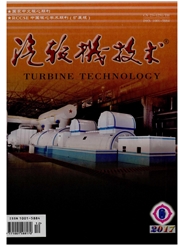

 中文摘要:
中文摘要:
为了较准确计算汽轮机转子的热应力,比较了热固单、双向耦合模型在热传导方程和求解方式上的差异。基于热固单、双向耦合模型,计算了某亚临界高中压转子在冷、热态两种启动工况下的瞬态温度场和热应力场,研究了冷、热态启动工况以及不同热冲击程度下两种模型计算结果的差异。结果表明:转子与主蒸汽温差在冷态启动下低于240℃,在热态启动下低于130℃时,单、双向计算模型结果相差均在2%左右,随着冲转初期转子所受热冲击程度增加,两模型计算结果偏差逐渐加大,最大可达20%;冷态启动下,转子表面温度低于主蒸汽温度,单向模型计算的最大热应力大于双向耦合模型计算结果;而热态启动时,转子表面温度高于主蒸汽温度,单向模型计算的最大热应力小于双向模型计算的结果,因此对于热态启动,单向模型计算的热应力是偏小的。该研究可为汽轮机转子热应力计算模型的选取提供参考。
 英文摘要:
英文摘要:
To accurately calculate thermal stress of steam turbine rotor, the heat conduction equation and the solving method for the uncoupling and coupling models for calculating thermal stress are compared. The transient temperature field and thermal stress field of a high and intermediate pressure rotor of a subcritical pressure steam turbine are calculated under the cold and hot start-up conditions using the two kind of calculated models. Differences of calculated results in the different start-up conditions and degrees of thermal shock are studied. The results show that the gap of thermal stress results by the two models is about 2% ,when the temperature difference between rotor and main steam is less than 240℃ in cold start-up condition and 130℃ in hot start-up condition, and the gap will become bigger with the degree of thermal shock, and the maximum is 20%. In the cold start-up condition, the rotor surface temperature is less than the main steam temperature, and the calculated maximum thermal stress of the uncoupling model is greater than the coupling model' s. The calculated maximum thermal stress is smaller than the coupling model' s. The research can provide reference for choosing calculated model of thermal stress.
 同期刊论文项目
同期刊论文项目
 同项目期刊论文
同项目期刊论文
 期刊信息
期刊信息
